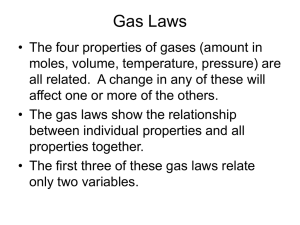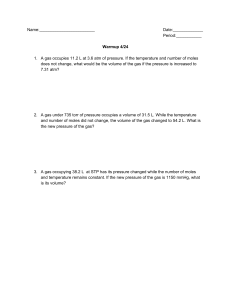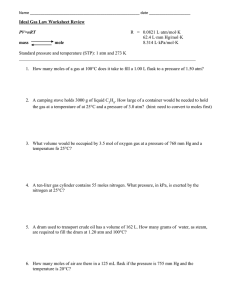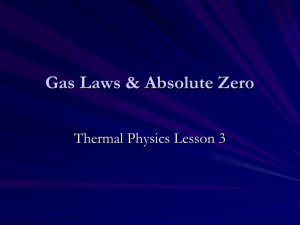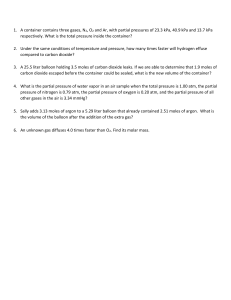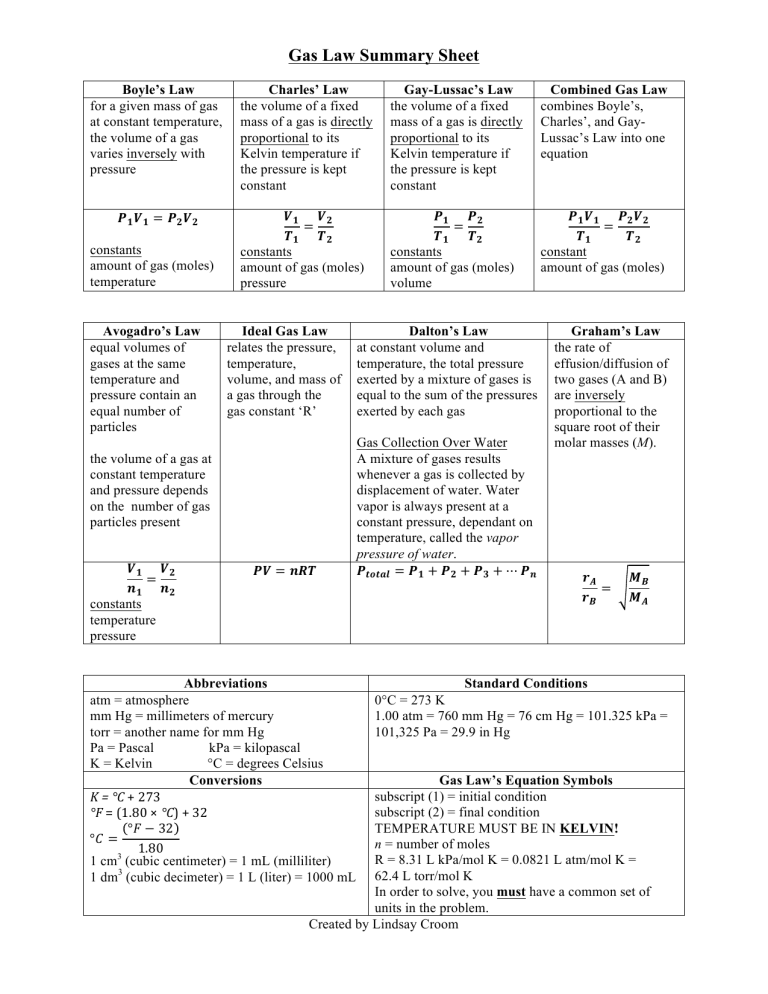
Gas Law Summary Sheet Boyle’s Law for a given mass of gas at constant temperature, the volume of a gas varies inversely with pressure 𝑷𝟏 𝑽𝟏 = 𝑷𝟐 𝑽𝟐 constants amount of gas (moles) temperature Avogadro’s Law equal volumes of gases at the same temperature and pressure contain an equal number of particles Charles’ Law the volume of a fixed mass of a gas is directly proportional to its Kelvin temperature if the pressure is kept constant Gay-Lussac’s Law the volume of a fixed mass of a gas is directly proportional to its Kelvin temperature if the pressure is kept constant Combined Gas Law combines Boyle’s, Charles’, and GayLussac’s Law into one equation 𝑽𝟏 𝑽𝟐 = 𝑻𝟏 𝑻𝟐 constants amount of gas (moles) pressure 𝑷𝟏 𝑷𝟐 = 𝑻𝟏 𝑻𝟐 constants amount of gas (moles) volume 𝑷𝟏 𝑽𝟏 𝑷𝟐 𝑽𝟐 = 𝑻𝟏 𝑻𝟐 constant amount of gas (moles) Ideal Gas Law relates the pressure, temperature, volume, and mass of a gas through the gas constant ‘R’ Dalton’s Law at constant volume and temperature, the total pressure exerted by a mixture of gases is equal to the sum of the pressures exerted by each gas 𝑷𝑽 = 𝒏𝑹𝑻 Gas Collection Over Water A mixture of gases results whenever a gas is collected by displacement of water. Water vapor is always present at a constant pressure, dependant on temperature, called the vapor pressure of water. 𝑷𝒕𝒐𝒕𝒂𝒍 = 𝑷𝟏 + 𝑷𝟐 + 𝑷𝟑 + ⋯ 𝑷𝒏 the volume of a gas at constant temperature and pressure depends on the number of gas particles present 𝑽𝟏 𝑽𝟐 = 𝒏𝟏 𝒏𝟐 constants temperature pressure Abbreviations atm = atmosphere mm Hg = millimeters of mercury torr = another name for mm Hg Pa = Pascal kPa = kilopascal K = Kelvin °C = degrees Celsius Conversions K = °C + 273 °F = (1.80 × °C) + 32 °𝐹 − 32 °𝐶 = 1.80 1 cm3 (cubic centimeter) = 1 mL (milliliter) 1 dm3 (cubic decimeter) = 1 L (liter) = 1000 mL Graham’s Law the rate of effusion/diffusion of two gases (A and B) are inversely proportional to the square root of their molar masses (M). 𝒓𝑨 = 𝒓𝑩 𝑴𝑩 𝑴𝑨 Standard Conditions 0°C = 273 K 1.00 atm = 760 mm Hg = 76 cm Hg = 101.325 kPa = 101,325 Pa = 29.9 in Hg Gas Law’s Equation Symbols subscript (1) = initial condition subscript (2) = final condition TEMPERATURE MUST BE IN KELVIN! n = number of moles R = 8.31 L kPa/mol K = 0.0821 L atm/mol K = 62.4 L torr/mol K In order to solve, you must have a common set of units in the problem. Created by Lindsay Croom

